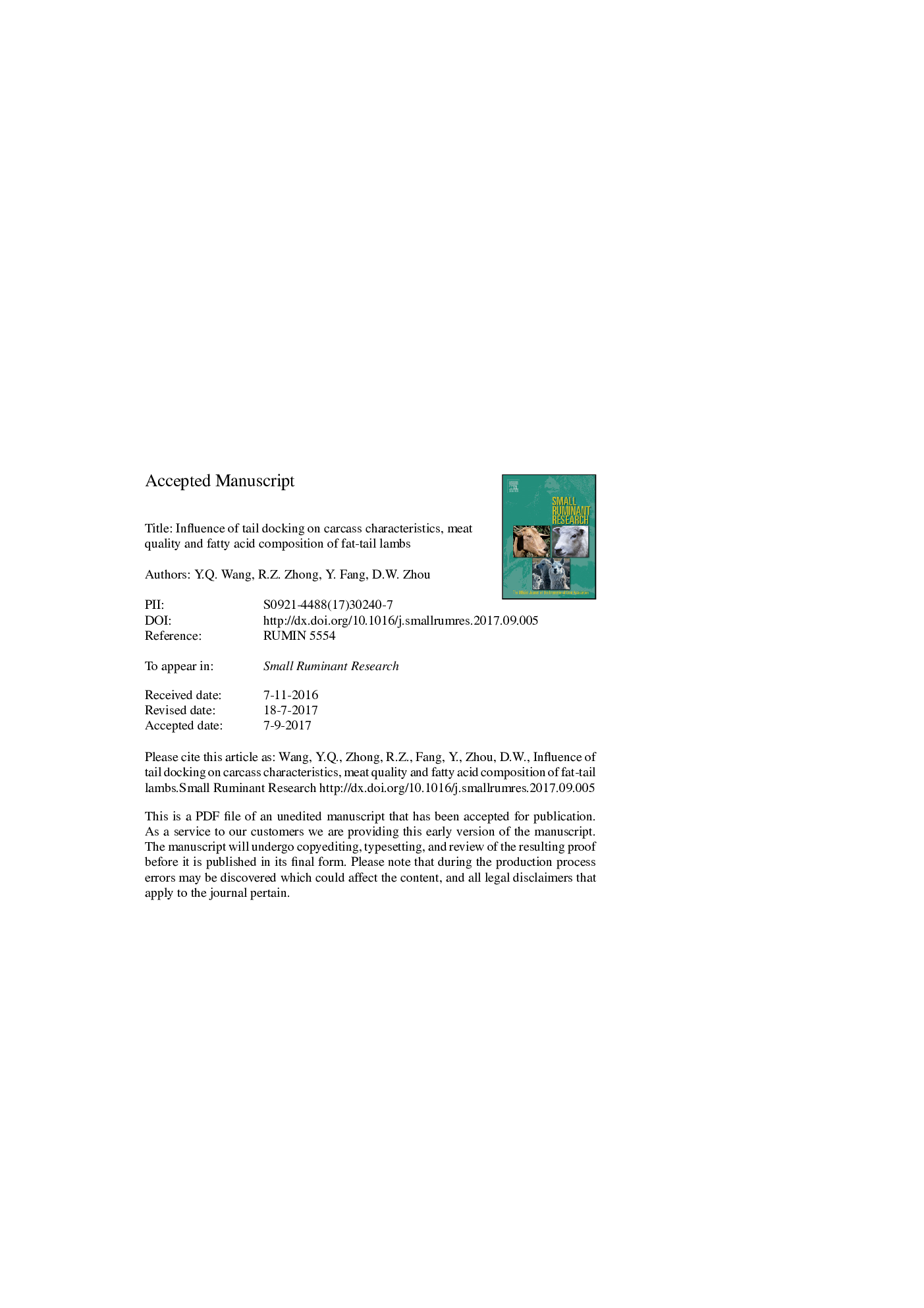| کد مقاله | کد نشریه | سال انتشار | مقاله انگلیسی | نسخه تمام متن |
|---|---|---|---|---|
| 8504213 | 1554330 | 2018 | 22 صفحه PDF | دانلود رایگان |
عنوان انگلیسی مقاله ISI
Influence of tail docking on carcass characteristics, meat quality and fatty acid composition of fat-tail lambs
ترجمه فارسی عنوان
تأثیر دمیدن دم در ویژگی های لاشه، کیفیت گوشت و ترکیب اسید چرب از بره های چربی دم
دانلود مقاله + سفارش ترجمه
دانلود مقاله ISI انگلیسی
رایگان برای ایرانیان
کلمات کلیدی
بره ها، پایه دم کیفیت گوشت، ترکیب اسید چرب،
موضوعات مرتبط
علوم زیستی و بیوفناوری
علوم کشاورزی و بیولوژیک
علوم دامی و جانورشناسی
چکیده انگلیسی
The objective was to determine effects of tail docking on carcass characteristics and meat quality of fat-tail lambs. We tested the hypothesis that tail-docked lambs have greater fat content in their muscle and meat, and their carcass has better nutritional quality. Twenty lambs were randomly allocated into two groups, Control and Tail docked (application of rubber ring distal end of the caudal fold at 1 d of age). All lambs grazed on pasture (weaned at 46 d of age) until they were slaughtered at 6 mo. The longissimus dorsi (LD) and gluteus maximus (GM) muscles were collected and the carcass evaluated. Carcass weight, dressing percentage, average daily gain (Pâ¯<â¯0.001), eye muscle area (Pâ¯<â¯0.05), back fat thickness, rump fat weight, and rumen epiploic fat weight (Pâ¯<â¯0.001) were increased in Tail-docked lambs, as were intramuscular fat (IMF, Pâ¯<â¯0.01) and the L* value (Pâ¯<â¯0.05). Furthermore, in Tail-lambs lambs, there was decrease in hue angle (H°) value (Pâ¯<â¯0.05) of the LD muscle. In addition, shear force (Pâ¯<â¯0.001) of LD muscle, drip loss (Pâ¯<â¯0.001) of the LD muscle and shear force (Pâ¯<â¯0.01) of the GM muscle were decreased in Tail-docked lambs. Most saturated fatty acids (SFA) were affected by tail docking, except C16:0, C18:0 and C20:0. For monounsaturated fatty acids (MUFA), concentrations of C16:1 (Pâ¯<â¯0.01) and C18:1n-9 (Pâ¯<â¯0.001) were higher in Tail-docked lambs, as were concentrations of C18:3n-3, SFA and n-3. However, polyunsaturated fatty acid (PUFA), concentrations of C18:2n-6, C20:3n-6 and C20:4n-6, PUFA, n-6, PUFA/SFA and n-6/n-3 ratios were all lower (Pâ¯<â¯0.01) in Tail-docked lambs. In conclusion, as expected, in Tail-docked lambs, tail fat was re-directed into muscle; therefore, tail docking improved meat quality, although it reduced PUFA concentrations and increased SFA concentrations in meat.
ناشر
Database: Elsevier - ScienceDirect (ساینس دایرکت)
Journal: Small Ruminant Research - Volume 162, May 2018, Pages 17-21
Journal: Small Ruminant Research - Volume 162, May 2018, Pages 17-21
نویسندگان
Y.Q. Wang, R.Z. Zhong, Y. Fang, D.W. Zhou,
